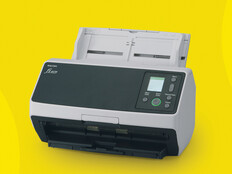Printers are not the only school essential that can be upgraded to support sustainability. Charging carts are another example. They typically rely on alternating-current adapters that are not only inefficient but also contribute significantly to electronic waste. They break often, adding to the ever-expanding global footprint of e-waste.
MORE ON EDTECH: Break/fix programs maintain one-to-one computing success.
JAR Systems addresses this with its Quick-Sense USB-C Charging Retrofit Kits. By getting rid of the AC adapters, schools trim their e-waste and save on the routine $35 to $45 expense of replacement parts. Moreover, the company’s USB-C cart can optimize energy use to dial down consumption, says JAR Systems Chief Revenue Officer Mike Faherty.
“USB-C has the capability to be a more efficient way to deliver power,” he says. “Our modules actually will sense what the power needs are of all the devices within the cart and will only deliver enough power to bring that device to a full charge, so there’s less power consumption overall.”
Finding Sustainable Solutions at the Building Level
Building management systems are another area where schools can leverage technology to improve energy efficiency.
At Schneider Electric, Tyler Haak points to digitization as the starting point. “Any school district can be working to digitize what have traditionally been analog systems so they can get that information and that data in a central spot,” says Haak, vice president of services.
With a digital building automation system, schools can look to optimize their energy use. Today, “automated fault detection diagnostics and AI come into play,” says Haak. These tools support the predictive maintenance that delivers maximum efficiency. “That can help us really put a dent in energy consumption, because HVAC systems can account for upward of 35% of energy consumption in the building.”
LEARN MORE: What technologies support modern facilities management in K–12 schools?
At the cutting edge are tools like CO2 sensors. “Carbon dioxide is a good proxy for how many people are in a space,” says Haak. A modern sensor can read CO2 levels to determine occupancy, “and it will allow the system to tune itself, so it’s always providing the appropriate amount of outside air. You have to treat that outside air with heating or cooling, and that’s where a lot of your energy consumption comes from.”
Identifying Resources and Opportunities for Sustainable Upgrades
For schools looking to leverage technology in support of their sustainability goals, Grossman says it makes sense to explore the options. “Especially if there are new construction projects, be sure to look for new sustainable methods for heating and cooling,” he notes.
As schools pursue sustainable tech solutions, they can look to the E-rate program to help fund certain upgrades, Grossman says. And school IT leaders can work closely with their vendors to find the solutions that best support efforts to both trim budgets and deliver greener approaches. “Do your research when you’re interviewing these vendors, and see what technologies they offer,” he says.
It makes sense, too, to check in with other K–12 IT professionals. “I’m part of a tech LISTSERV in Michigan, and we share information all the time,” Grossman adds. “There are a lot of others who are doing these sorts of projects.”












